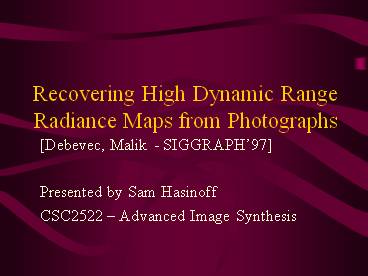Recovering High Dynamic Range Radiance Maps from Photographs - PowerPoint PPT Presentation
Title:
Recovering High Dynamic Range Radiance Maps from Photographs
Description:
'Range of signals within which we can operate with acceptable distortion' ... Or calibrate to a standard luminaire. Sample a small number of pixels. Perhaps N=50 ... – PowerPoint PPT presentation
Number of Views:65
Avg rating:3.0/5.0
Title: Recovering High Dynamic Range Radiance Maps from Photographs
1
Recovering High Dynamic Range Radiance Maps from
Photographs
- Debevec, Malik - SIGGRAPH97
- Presented by Sam Hasinoff
- CSC2522 Advanced Image Synthesis
2
Dynamic Range
- Range of signals within which we can operate
with acceptable distortion - Ratio brightest / darkest
Human Eye 10,0001
CRT 1001
Real-life Scenes up to 500,0001
3
Limited Dynamic Range
saturated
underexposed
4
The Main Idea
- How can we cover a wide dynamic range?
- Combine many photographs taken with different
exposures!
5
Where is this important?
- Image-based modeling and rendering
- More accurate image processing
- Example motion blur
- Better image compositing video
- Quantitative evaluation of rendering algorithms,
research tool
6
Image Acquisition
- Pipeline
- physical scene radiance (L) ?
- sensor irradiance (E) ?
- sensor exposure (X) ?
- development ? scanning ?
- digitization ?
- re-mapping digital values ?
- final pixel values (Z)
7
Reciprocity Assumption
- Physical property
- Only the product E?t affects the optical density
of the processed film - X E?t
- exposure X
- sensor irradiance E
- exposure time ?t
8
Formulating the Problem
- Nonlinear unknown function, f(X) Z
- exposure X
- final digital pixel values Z
- assume f increases monotonically (invertible)
- Zij f(Ei?tj)
- index over pixel locations i
- index over exposures j
9
Some Manipulation
- We invert to get f 1(Zij) Ei?tj
- g ln f 1
- g(Zij) ln Ei ln ?tj
- Solve in the least-error sense for
- sensor irradiances Ei
- smooth, monotonic function g
10
Picture of the Algorithm
11
Solution Strategy
- Minimize
- Least-squared error
- Smoothness term
- Exploit discrete, finite world
- N pixel locations
- Domain of Z is finite (Zmax Zmin 1)
- Linear least-squares problem (SVD)
12
Formulae
- Given
- Find the
- N values of ln Ei
- (Zmax Zmin 1) values of g(z)
- That minimizes the objective function
13
Getting a Better Fit
- Anticipate the basic shape
- g(z) is steep and fits poorly at extremes
- Introduce a weighting function w(z) to emphasize
the middle areas - Define Zmid ½(Zmin Zmax)
- Suggested w(z)
- z Zmin for z Zmid
- Zmax z for z gt Zmid
14
Revised Formulae
- Given
- Minimize the objective function
15
Technicalities
- Only good to some scale factor (logarithms!)
- Add the extra constraint Zmid 0
- Or calibrate to a standard luminaire
- Sample a small number of pixels
- Perhaps N50
- Should be evenly distributed from Z
- Smoothness term
- Approximate g with divided differences
- Not explicitly enforced that g is monotonic
16
Results 1
actual photograph (?t 2 s)
radiance map displayed linearly
17
Results 2
lower 0.1 of the radiance map (linear)
false color (log) radiance map
18
Results 3
histogram compression
plus a human perceptual model
19
Motion Blur
actual blurred photograph
synthetically blurred digital image
synthetically blurred radiance map
20
Video
- FiatLux (SIGGRAPH99)
- Better image compositing using high dynamic range
reflectance maps
21
The End?
- References (SIGGRAPH)
- High Dynamic Range Radiance Maps (1997)
- Synthetic Objects Into Real Scenes (1998)
- Reflectance Field of a Human Face (2000)
- Questions































